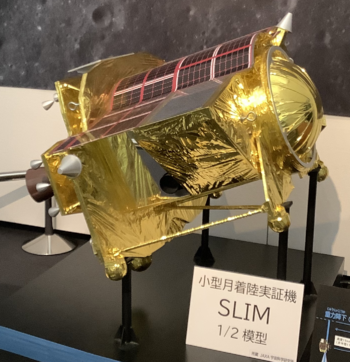Smart Lander for Investigating Moon facts for kids

Half scale model of SLIM in landing configuration
|
|
| Names | SLIM |
|---|---|
| Mission type | Lunar lander and Lunar rover |
| Operator | JAXA |
| Mission duration | 2 years, 4 months, 13 days (elapsed) (since launch) 1 year, 11 months, 30 days (since landing) |
| Spacecraft properties | |
| Manufacturer | MELCO |
| Launch mass | 590 kg |
| Dry mass | 120 kg |
| Dimensions | 1.5 × 1.5 × 2 m (4 ft 11 in × 4 ft 11 in × 6 ft 7 in) |
| Start of mission | |
| Launch date | 6 September 2023 23:42:11 UTC |
| Rocket | H-IIA 202 |
| Launch site | Tanegashima Space Center |
| Contractor | Mitsubishi Heavy Industries |
| Lunar orbiter | |
| Orbital insertion | 25 December 2023 07:51 UTC |
| Lunar lander | |
| Landing date | 19 January 2024 15:20:00 UTC |
| Landing site | 13°18′S 25°12′E / 13.3°S 25.2°E (near Shioli crater) |
The Smart Lander for Investigating Moon (SLIM) is a special spacecraft from Japan. It was built by the Japan Aerospace Exploration Agency (JAXA). SLIM's main job was to land very precisely on the Moon.
SLIM was launched into space on September 6, 2023. It reached the Moon's orbit on December 25, 2023. Then, on January 19, 2024, it successfully landed on the Moon. This made Japan the fifth country to achieve a soft landing on the Moon's surface.
Contents
What is SLIM's Main Goal?
The main goal of SLIM was to show that a spacecraft could land on the Moon with extreme accuracy. This means landing very close to a specific spot. Most Moon landings have a landing area that is several kilometers wide. SLIM aimed to land within a small circle of just 100 m (330 ft) (about 328 feet).
To do this, SLIM used special technology. It could recognize lunar craters (Moon craters) like a face recognition system recognizes faces. It also used maps made by another Japanese Moon orbiter called SELENE (Kaguya). Landing so precisely helps future space missions explore specific areas of the Moon.
How Was SLIM Developed?
The idea for SLIM started way back in 2005. It was first called the Small Lunar Landing Experiment Satellite. In 2013, JAXA asked for new mission ideas, and SLIM was chosen. By 2016, SLIM became a full project within JAXA.
Mitsubishi Electric (MELCO) was chosen to build the spacecraft. SLIM was originally planned to launch in 2021. However, its launch was delayed to 2023. This was because it was sharing a rocket ride with another mission called XRISM.
What Rovers Did SLIM Carry?
SLIM carried two small robots, called rovers, to explore the Moon's surface.
Lunar Excursion Vehicle 1 (LEV-1)
LEV-1 is a special lunar rover that moves by hopping. It doesn't have wheels like a car. This hopping helps it move around the Moon's surface.
LEV-1 can talk directly to Earth. It has two cameras to take pictures. It also carries scientific tools like:
- A thermometer to measure temperature.
- A radiation monitor to check radiation levels.
- An inclinometer to measure how tilted it is.
Lunar Excursion Vehicle 2 (LEV-2)
LEV-2 is a very small rover, also known as SORA-Q. It was made by JAXA with help from companies like Tomy and Sony Group. This tiny rover weighs only 250 grams (about half a pound).
LEV-2 has two small cameras. It can change its shape to roll or move on the Moon. It was designed to work for about two hours on the lunar surface.
SLIM's Journey to the Moon
SLIM launched on September 6, 2023, along with the XRISM space telescope. It was launched from the Tanegashima Space Center in Japan. After launch, SLIM separated from XRISM.
On December 25, 2023, SLIM successfully entered orbit around the Moon. Then, on January 19, 2024, it began its descent. The lander, nicknamed Moon Sniper because of its amazing accuracy, touched down near the Shioli crater. This area is in a part of the Moon called the Sea of Nectar.
After the landing, Japan became the fifth country to successfully land a spacecraft softly on the Moon. The other countries are the Soviet Union, United States, China, and India.
Right after landing, SLIM's solar panels were not facing the Sun. This meant they couldn't make electricity. The lander used its internal battery, which ran out quickly. However, the mission team hoped SLIM would "wake up" when the Sun's light hit its solar panels again a few days later.
The two small rovers, LEV-1 and LEV-2, were released by SLIM just before it landed. Both rovers worked as planned. LEV-1 was even able to send signals directly back to Earth!
Images for kids
See also
 In Spanish: SLIM (módulo de aterrizaje) para niños
In Spanish: SLIM (módulo de aterrizaje) para niños
- Japanese Lunar Exploration Program
- Hiten
- LUPEX
- Chandrayaan-3
- List of missions to the Moon



